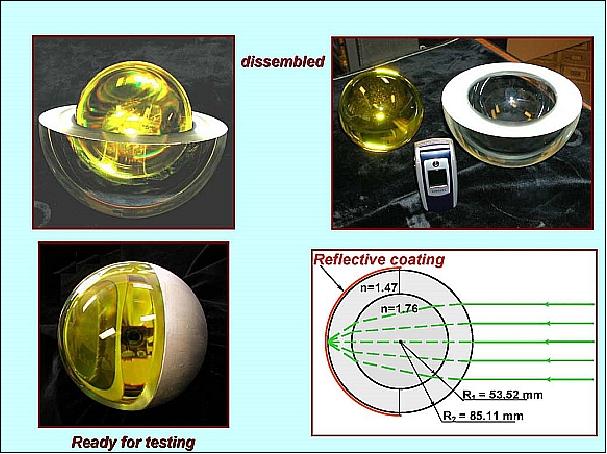#Y2024 #天文光学
Update date: 2024/12/30
[Link](https://www.eoportal.org/satellite-missions/blits#9987.507841597822)
## BLITS (Ball Lens In The Space)
BLITS is a retroreflector demonstration nanosatellite, a geodetic sphere, which was designed and manufactured by the FSUE-IPIE (Federal State Unitary Enterprise - Institute for Precision Engineering) R&D center (Moscow, Russia), under a 2006 agreement between Roskosmos and ILRS (International Laser Ranging Service). The purpose of the mission is experimental verification of the spherical glass retroreflector (low-refraction index glass, LK6 type) satellite concept. [1)](https://www.eoportal.org/satellite-missions/blits#foot1%29) [2)](https://www.eoportal.org/satellite-missions/blits#foot2%29)
The BLITS retroreflector has a heritage of a small spherical retroreflector of the same type (6 cm in diameter) which was flown on the Meteor-3M spacecraft (launch Dec. 10, 2001) and tested during the timeframe 2001-2006 by the ILRS (International Laser Ranging Service). [3)](https://www.eoportal.org/satellite-missions/blits#foot3%29)
Note: The FSUE-IPIE research institute is referred to in Russian as NIIPP (NII Pretsizionnogo Priborostroeniya).
## Spacecraft
BLITS is a passive nanosatellite, consisting of two outer hemispheres made of a low-refraction-index glass (LK6 type) and an inner ball lens made of a high-refraction-index glass (TF105 type). The ball lens radius is 53.52 mm, the total radius of the spherical retroreflector is 85.16 mm. The hemispheres are glued over the ball lens; the external surface of one hemisphere is covered with an aluminum coating protected by a varnish layer. All spherical surfaces are concentric.
The nanosatellite is being used for precise SLR (Satellite Laser Ranging) measurements from the ILRS ground station network. The BLITS retroreflector should have zero ‘signature’ and thus represent the most accurate geodetic satellite currently in orbit. [4)](https://www.eoportal.org/satellite-missions/blits#foot4%29)
The nanosatellite has an outer diameter of ~17 cm and a mass of 7.53 kg. The expected mission design life is 5 years.
比起常见的角反射器,这种球形的回射器是这个卫星实验的重点,是为了消除大地测量中的satellite signature effect卫星特征,所以这个球被称为大地测量的零特征卫星。
参考论文[method to calculate zero-signature satellite laser ranging normal points for millimeter geodesy - a case study with Ajisai](https://earth-planets-space.springeropen.com/articles/10.1186/s40623-015-0204-4)

---
版权声明: 感谢您的阅读,本文由[超光](https://faster-than-light.net/)版权所有。如若转载,请注明出处。